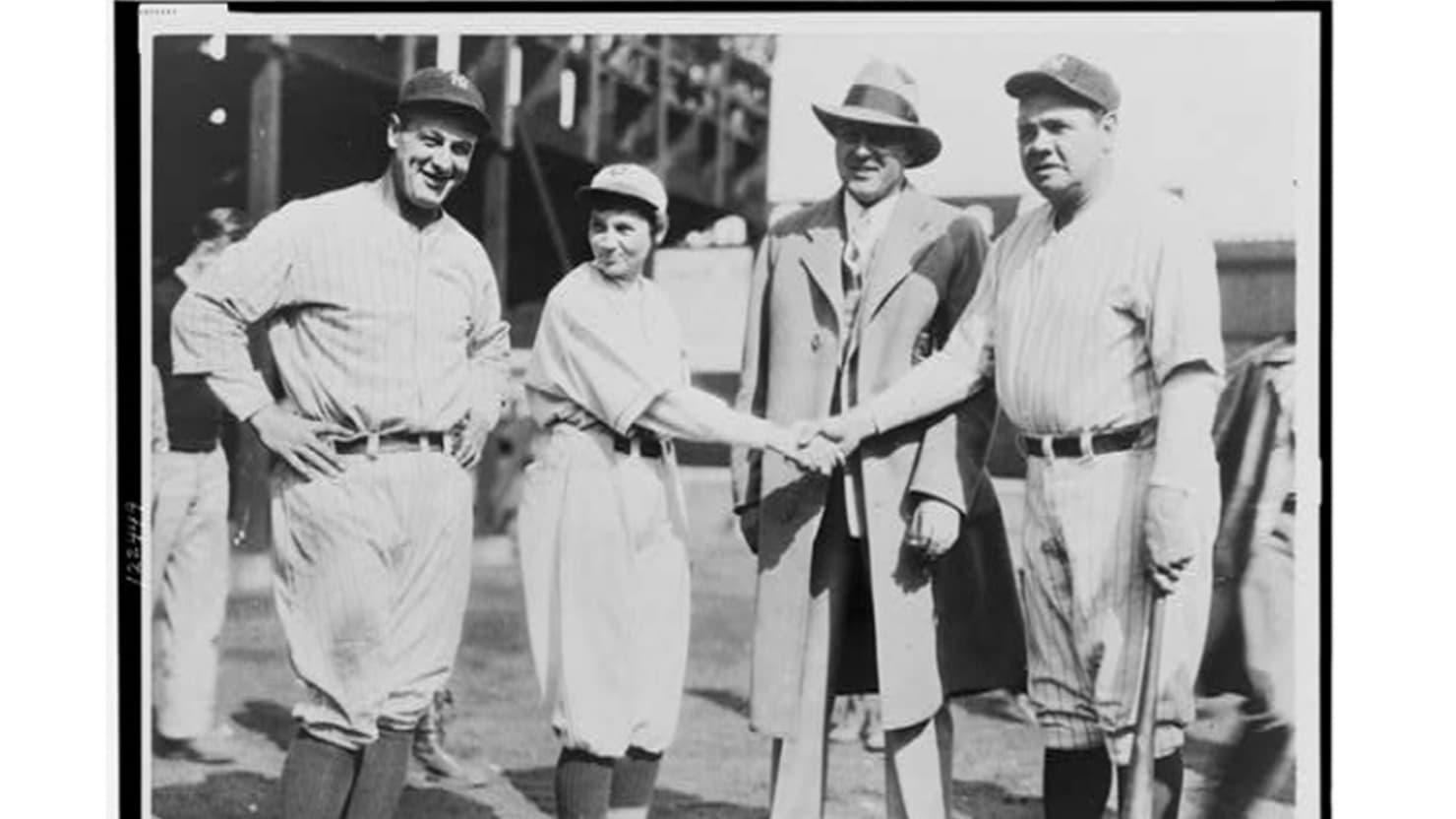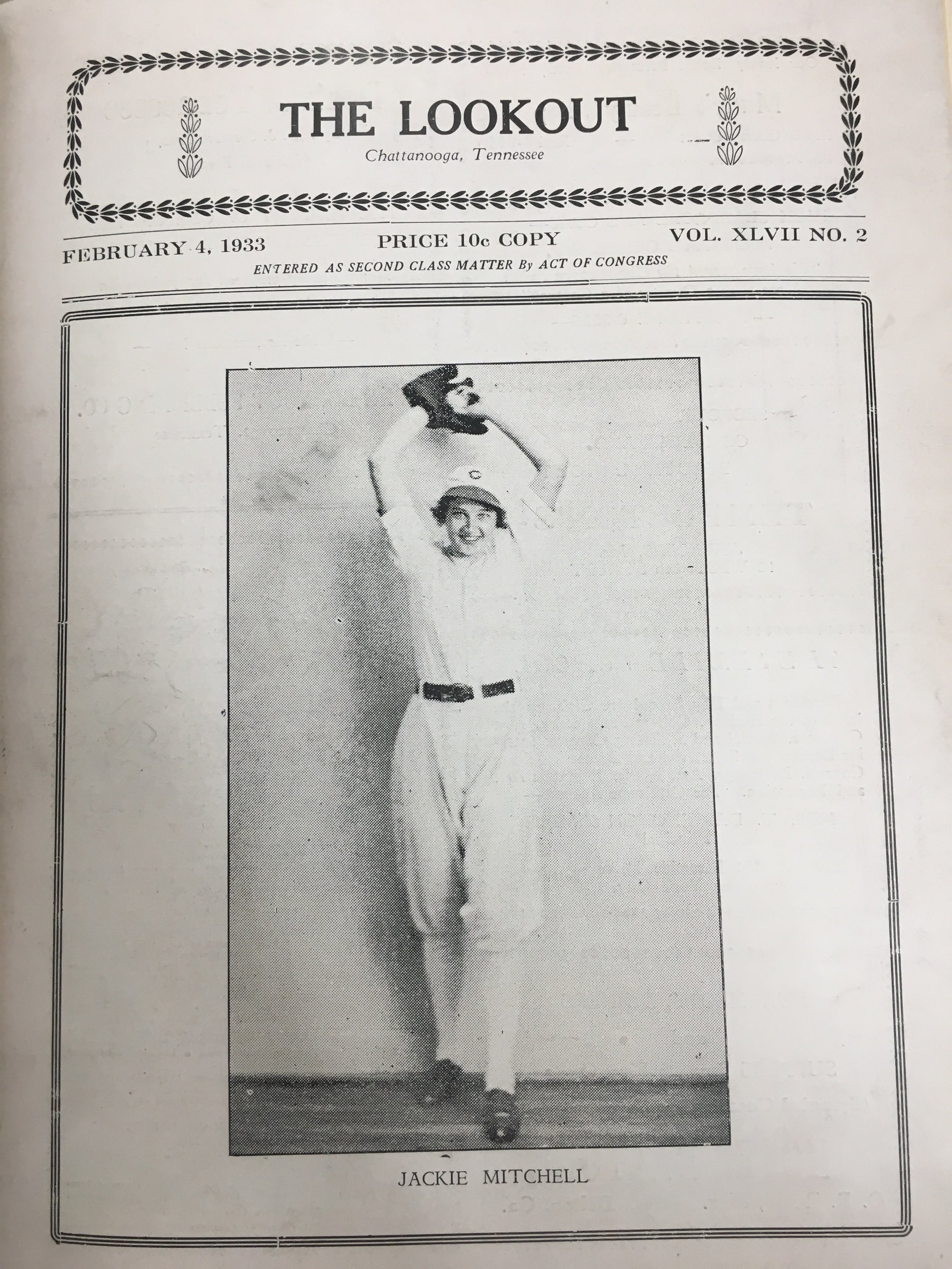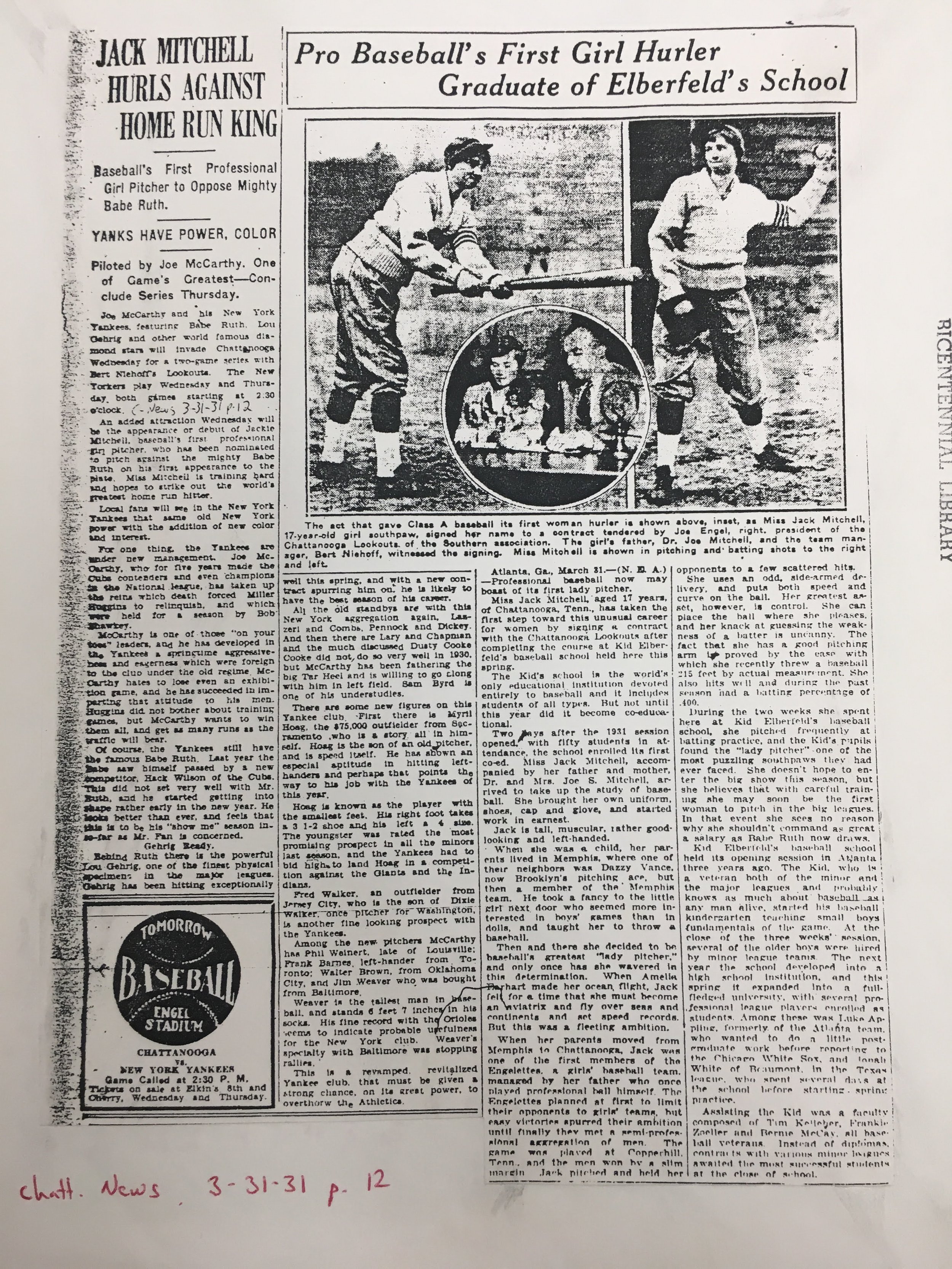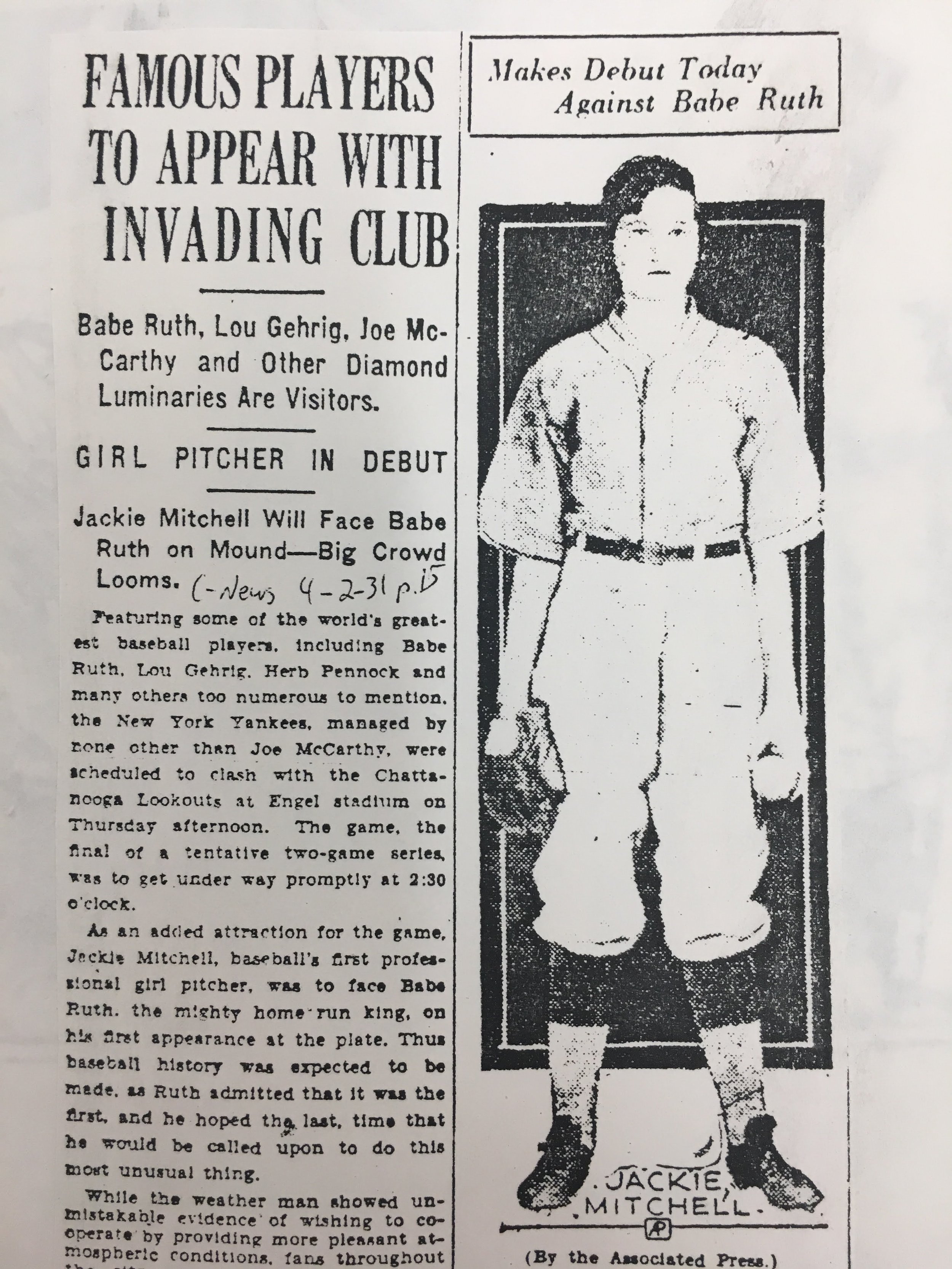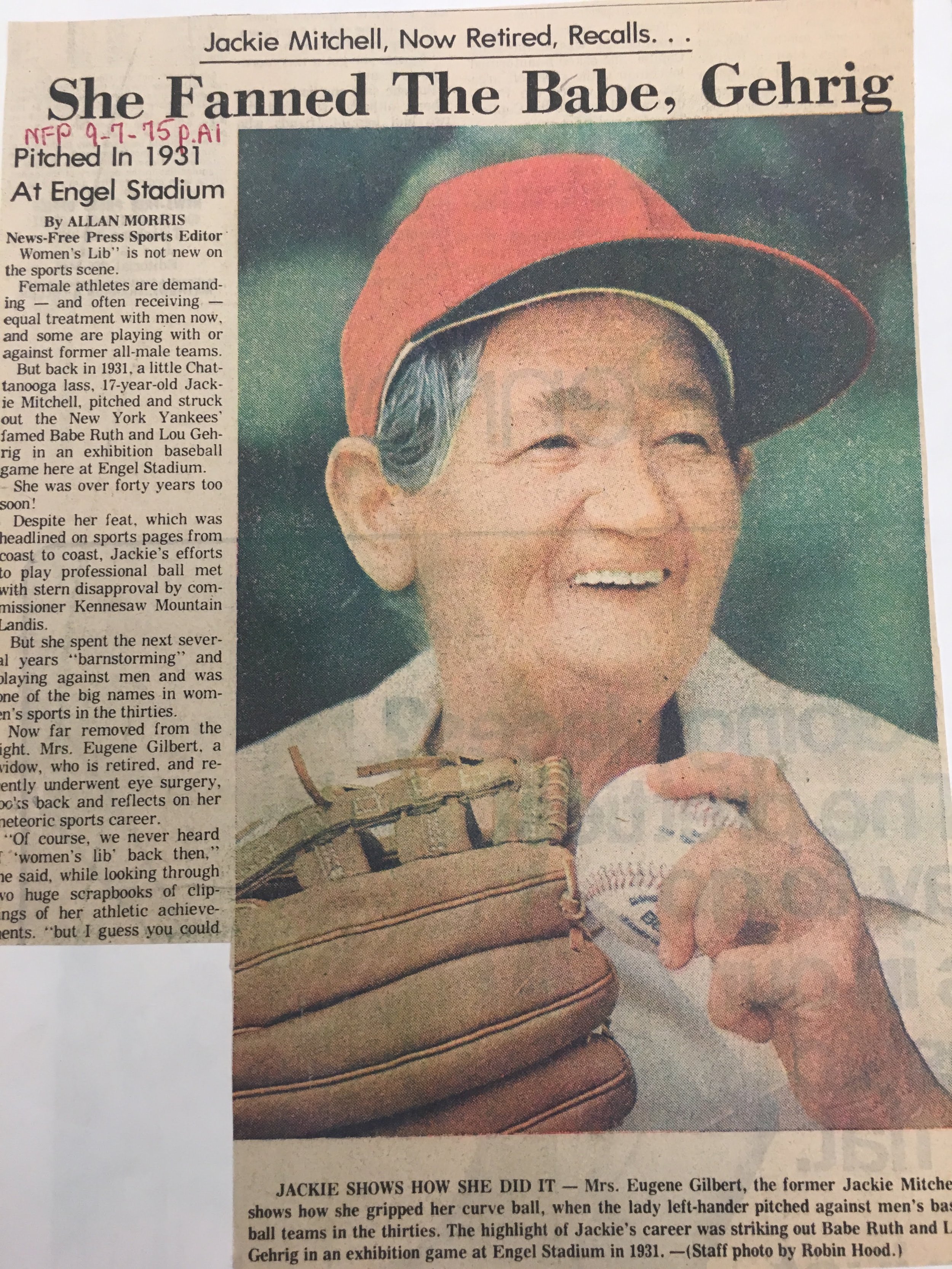The Girl Who Struck Out Babe Ruth
written by Kate Harrison Belz
Pitcher Jackie Mitchell shaking hands with Babe Ruth, while Lou Gehrig (left) and Joe Engel stand by, 1931 (Library of Congress)
The Jackie Mitchell legend, and why it still captivates
The rain had cleared, and 4,000 people filed into Engel Stadium to witness the impossible.
It was April 2, 1931, and the New York Yankees had come to Chattanooga to play an exhibition game against the Chattanooga Lookouts. The chance to watch Babe Ruth, Lou Gehrig, and the other players of “Murderers’ Row” on the diamond was already enough to draw a crowd. But the spectators — and the reporters who had been dispatched to the city — were there for a bigger story.
Finally, she took the mound. The Lookouts’ newest pitcher was dressed in a baggy baseball uniform, her brown hair tucked into a cap. Jackie Mitchell, 18, held the ball in her left hand and took stock of the batter facing her: Babe Ruth. The Great Bambino. The Sultan of Swat.
Mitchell spat in her glove, wound up, and Ruth took a ball. Next, Mitchell threw a curveball. Ruth swung and missed. She hurled another one. He swung, and missed again. He then insisted the umpire examine the ball. After this was done, Mitchell wound up and threw a third pitch down the middle of the plate. Ruth didn’t swing. Strike three.
An old film reel of the game shows Ruth flinging down his bat and storming off.
Behind Ruth was Lou Gehrig. Mitchell struck him out in three pitches. She walked Tony Lazzeri, and was then pulled off the mound. The Lookouts lost the game, but the front-page headlines were set:
RUTH AND GEHRIG STRUCK OUT BY GIRL
GIRL HURLER FANS RUTH
HER CURVES FOOL ‘EM!
The story of Jackie Mitchell — the teenage girl who struck out Ruth and Gehrig — has developed its own mythos since that day. Largely forgotten by Chattanoogans, the story has fascinated and perplexed baseball historians across the country. Who was this young woman, and did she really strike out two of baseball’s most legendary players? Or was it an elaborate ruse concocted by Lookouts manager and premier showman Joe Engel?
Amidst the debate, some wonder if the real heart of Jackie’s story has been overlooked.
Andy Broome, baseball card grader for Beckett Media and a Chattanooga native who has spent eighteen years researching Jackie Mitchell’s story, says that Mitchell’s importance goes beyond the fateful game.
“When you dig deeper into her story, you see that was ready to face this, and to show what she could really do,” says Broome. “She knew how it important was to show that women could compete on a major league level.”
Janna Jahn, who founded the Engel Foundation to save historic Engel Stadium from destruction, says the story speaks to debates we’re still having nearly 90 years later about women in sports.
“I think the deeper question behind of all this has not been just whether or not she struck out Babe Ruth — but whether or not women could play baseball competitively with men,” says. “If she could, what are the implications of that?”
So, who was Jackie Mitchell, and how did she get into baseball?
“Jackie grew up with baseball,” says Broome. Her father had played in the Cotton States League, and had encouraged his daughter to play ball and other sports from a young age. When the family lived in Memphis, they lived near hall-of-fame pitcher Dazzy Vance, who taught Mitchell pitching technique and likely influenced her curve ball.
After the family moved to Chattanooga, she played on a women’s baseball team and attended an Atlanta training school for ball players. It was during this time Jackie caught the attention of Joe Engel, president of the Chattanooga Lookouts, who saw something special in the pitcher’s wicked left arm, and in her personality.
“She was outgoing, but she was also really serious about the game,” says Broome. “He saw incredible talent, but saw she could perform in front of a crowd. She could handle the pressure.”
Why did Joe Engel want to bring her onto the Lookouts?
Joe Engel, dubbed the “Barnum of the Bush Leagues,” knew how to fill the seats, even during the Great Depression. “He was outrageous, and that’s how he kept people coming to the stadium,” says Jahn.
One opening day, he brought a circus to the park. At another game, he gave away an entire furnished house. Signing a teen girl to square off against the Yankees would be a spectacle the whole country would watch.
And Mitchell?
“She was doing what she enjoyed doing,” says Jahn. “She’d already been playing against men. She already knew she was good.”
Though she wasn’t the first girl to play in a men’s league— the ban on women playing professional baseball wouldn’t be instated till 1952 — Jackie’s contract with the Lookouts still made national news, and she was dubbed “organized baseball’s first girl pitcher.” Her contract signing March 28 was broadcast live, and the build-up to the big game began.
So what actually happened when Jackie Mitchell pitched against the Yankees?
Jackie was originally set to pitch against Ruth and Gehrig every time they were at bat. She trained incessantly to prepare for the game —so much that wore out her arm, which is reportedly why she pitched only one inning. If she had been able to pitch longer, Broome wonders if the debate over her skill would be different now.
Those who insist the inning was rigged point to Engel’s reputation for showmanship, and to the bare odds: How could an amateur teen possibly strike out the greatest players of the day?
Mitchell insisted the strikeouts were genuine up until her death in 1987, and Ruth and Gehrig never said otherwise. Lazzeri claimed he went out to hit the ball.
“Maybe they didn’t take her seriously,” says Jahn. “Maybe she did strike ‘em out. It wasn’t the last major league player she struck out. The girl had talent. She was challenging the status quo.”
Broome says his extensive research has not unearthed any indication of a hoax.
“The game itself was a publicity stunt, yes. But you examine at the backgrounds of everyone involved here, and you watch that video clip — you see the real deal,” he says. “You can say it was all ruse, but you can’t deny her pitching ability. You have to ask: Did Jackie give us a glimpse of what was possible?”
What kind of impact did Jackie’s strikeouts have on baseball? On Jackie herself?
Though the game was a national sensation, it was treated as a novelty — not a bellwether, says Broome.
Jackie went on to play for Chattanooga Junior Lookouts, another club run by Engel, and then a few other minor league teams before signing with the House of David, a famous semi-pro barnstorming team. In 1933, she pitched against the St. Louis Cardinals, and won. Eventually weary of the exploits, Jackie retired in 1937 and went to work for her father.
She married, but had no children, and lived a private life. She died in 1987 and was buried in Forest Hills Cemetery. The first time Broome went to visit her grave (it’s a “home run’s distance from Joe Engel’s grave,” he says) half of the marker was completely grown over with grass.
“I realized she had no one to tell her story,” he says.
Why is Jackie Mitchell’s story so important?
“The event itself is an important milestone in the baseball history, and the history of women in professional sports,” says Broome.
The Mitchell story also says a lot about Chattanooga’s storied role in sports history, both say.
As the Chattanooga continues to bill itself as a sports and outdoor hub, Broome wonders if this history can be brought more to the forefront. The Chattanooga-area continues to host large youth softball and baseball tournaments — “And how great would it be to have that tournament in a Jackie Mitchell stadium?” he asks.
Jackie Mithell is featured in a 1975 story from the News-Free Press reflecting on her career. (Chattanooga Public Library archives)

